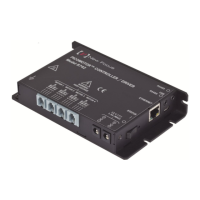Remote Command Set 65
6.1.1 RS-485 Command Syntax
The command syntax for communicating with controllers on an RS-485 network is
very similar to communicating with them directly using USB/Ethernet interface with
the following exceptions.
1. All the commands intended for a slave controller must have a slave
controller address prefix added to the command. For example, to query
the motion status of motor 2 on a slave controller with address 3, the host
PC must send “3>2MD?” command to the master controller. In this
command, “3>” is the slave controller address prefix. This prefix tells
the master controller that the command “2MD?” is intended for slave
controller with address 3.
2. When the master controller sends a response back to host PC, it too will
have a slave controller address prefix. This is used to inform the host
that the response came from a slave controller with that address. For
example, the response received by a host PC to the above mentioned
command might be “3>1”. This indicates that the motion of motor #2 in
slave controller with address 3 is complete.
3. If a command does not have controller address prefix, the master
controller will assume that the command is addressed it and process the
same.
4. Since the master controller processes one command string at a time,
semicolon (‘;’) delimited commands cannot be sent to slave controllers.
NOTE
A controller command (or a sequence of commands) has to be terminated with
a carriage return character. However, responses from the controller are
always terminated by a carriage return/line feed combination. This setting may
not be changed.

